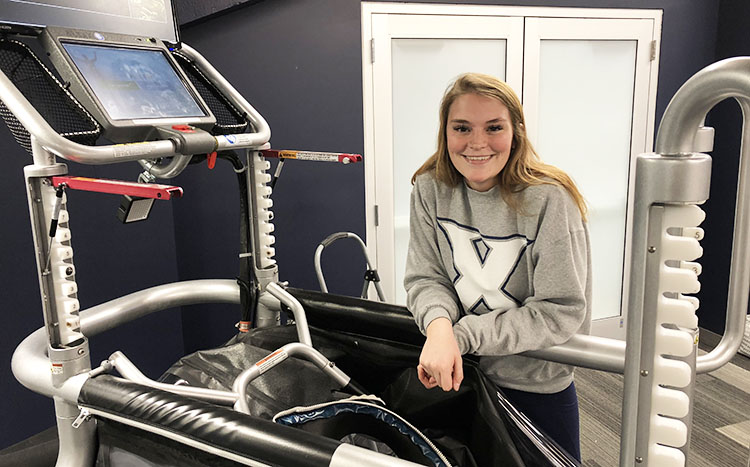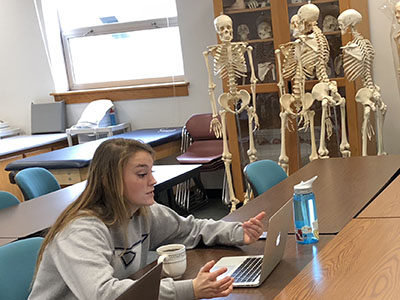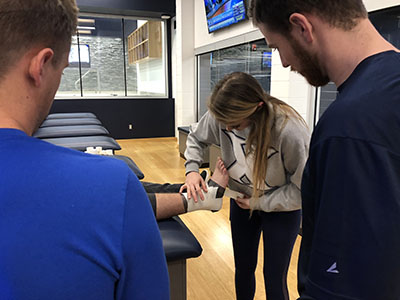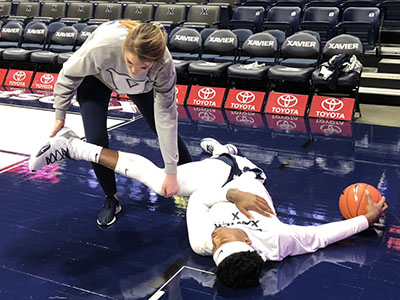
Training Day
Jan 14, 2019
Xavier Athletic Training program helps prepare students like Tori DiMattio for ‘real world’
By Ryan Clark
Tori DiMattio walks fast. She doesn’t want to be late. But she always seems to be in constant motion, like a hummingbird in Nikes, flying from class to jobs to internships.
It’s 9:45 a.m. on a bright, cool Tuesday morning, and she’s making her way across campus to the Schmidt Fieldhouse. As a student in the Athletic Training program, she will be leading a class discussion on the treatment of certain injuries.
Of course, Tori’s day already began a few hours ago. At 6:30 a.m. she was studying, eating breakfast and doing homework, and by 8 a.m., she was shadowing a professional physical therapist downtown.
Then she hopped in her car and drove back to campus, ready for the start of the school day. It’s an abnormally busy 24 hours for Tori, as she will also serve as a student athletic trainer for the defending conference champion men’s basketball team in their first game of the season later that night.
“I think the athletic training program at Xavier has really prepared me to be a practicing clinician,” says the 22-year-old, who played basketball and volleyball while growing up in Boise, Idaho.
“I think I will be able to work in a setting and provide as good of patient care as anyone,” she says. “The education here has been tailored to fit what I need to work on. It’s really helped to guide my path to what I want to do when I graduate.”
10:00 A.M.—11:30 A.M.
She came to Xavier for moments like this.
Today, Tori has been tasked with leading her classroom talk on the topic of treating injuries. She seems like a natural teacher, moving confidently through the material. As she grows more comfortable, she ends up telling a story about how when she was little, a sibling accidentally dropped an encyclopedia on her head, cutting her face.
Her mother put super glue on it, which—in a pinch—turns out to be a perfectly viable way to close a wound.
But that’s not exactly what Tori is preparing to do. She’s earned a coveted internship at Xavier as a student athletic trainer with the men’s basketball team, and later today they will play in their first home game. Tori will sit on the bench with the team and be on call should any injuries occur. It’s internships, or “clinicals,” like these that prepare Xavier students for the real world.
“These clinical experiences are really impressive,” says Vicky Graham, a visiting teaching professor in the Department of Sport Studies. “These multiple opportunities make sure our students are ready when it’s time to interview and, most importantly, when it’s time to really perform on the job.”
11:30 A.M.—3:00 P.M.
It’s time to head over to the Cintas Center, where Tori will spend the remainder of her day.
In the arena, she sets up in the athletic training facility, which is a flurry of activity. Athletes and athletic trainers scurry about, tending to various ailments or stretching to prevent them. Tori signs in for her job as an administrator in the department. Here, she’s in charge of things like inputting insurance data into their computers, or preparing locker rooms for the night’s game.
She’s also serving in a dual role, helping out as the student athletic trainer working under staff athletic trainers, which means she’s utilizing Xavier’s assorted equipment to help athletes with preventative maintenance as well as complete rehabilitations post-injury. She’ll do things like tape ankles, help stretch the athletes, create rehabilitation plans for the injured and utilize assorted therapeutic methods.
With little downtime, she tries to work in a midday meal, but things can get busy.
And, there’s a bit of nerves working, too. Although Tori has worked several clinicals before, including with the volleyball, soccer and baseball teams, this is a little different. Tonight, men’s basketball begins. The Cintas Center will be sold out, and the bright lights will be on.
“This is totally immersive, and people can get on edge,” says Tori, who is scheduled to graduate in the spring. “When we’re finished with school, we should have all the tools in our toolbox, everything we need, because of moments like this.”
3:00 P.M.—5:00 P.M.
Tori heads to the officials’ locker rooms to prepare them for the night’s game.
She’ll make sure they’re stocked with everything they need, then she’ll go to the visitors’ locker rooms and do the same.
Across the hall, in an auxiliary gym, the women’s team is going through practice. Connor Barnes, a 28-year-old assistant athletic trainer at Xavier, works with the women’s basketball squad and the cross-country teams. He knows exactly what Tori is going through, because he graduated from Xavier’s program in 2012.
“In the classroom itself, they teach all the main points you need to be an athletic trainer,” he says as he watches practice. “And our faculty to student ratio is amazing. The personal attention you get here is really unique. And when you’re able to do clinicals at a major Division I university like this, or at any of the professional or high school teams in Cincinnati, you’ve already established relationships, so you’ve already got your foot in the door when it’s time to get a job. It sets you up for great success.”
Back across the hall, some of the men’s basketball players are already on the court practicing their jumpers. Tori is making sure there’s enough water for them, as well as stretching out others, getting them prepared.
But there’s one other thing Tori has to check on before it gets really close to game time.
5:00 P.M.—7:00 P.M.
“She’s my personal stretcher,” says 6-9, 236-pound center Tyrique Jones. “She knows what she’s doing.”
Tori has the big man contorted into different shapes on the floor, stretching his legs and core so he can move adequately. It’s all part of her job.
“I get a lot of support working with the (players),” she says. “We can joke and kid with each other, but when I have to do my job, everyone is really professional.”
She tells Jones to get up and go back to work on his shooting. After grabbing dinner at the pre-game meal, she has to meet with Head Athletic Trainer David Fluker.
Fluker, who has worked for Xavier in two separate stints for a total of 14 years, was named head athletic trainer in August. He has so much faith in Tori’s abilities that he’s given her a special project.
In the preseason, one of Xavier’s players suffered an injury that caused him to miss some time in practice and in their exhibition games. Fluker assigned Tori the task of setting up the rehabilitation regimen.
“That’s not something you would get to do just anywhere,” she says.
In this program, students are able to work closely with staff athletic trainers, team physicians and physical therapists to create rehab plans as well as determine athletes’ status of play after injuries.
After watching the player in warmups, Tori and Fluker decide he will not be participating in the game tonight. He’s made progress, but he isn’t ready. And they have to let him know the disappointing news.
“All part of the job,” she says.
7:00 P.M.—11:45 P.M.
Tori changes into her Xavier polo and sits with Fluker just behind the bench.
It's the first game for the team, the first game for its new coach, Travis Steele, and the first game for Tori as student athletic trainer.
She hopes it goes well.
This night, Xavier complies, leading by three at halftime over IUPUI—with no significant injuries.
However, in the second half, new forward Zach Hankins is hit in the nose. He comes out of the game and immediately, Tori helps Fluker patch up the player’s nose and stop the bleeding.
“There’s more stress in those moments because it’s such a high-profile sport,” Tori says. “Everyone is really on edge because of that, hoping that it all goes right. We want it to go well.”
Xavier pulls away, winning 82-69, and spirits everywhere are good. Of course, Tori’s night is really just beginning. As part of her two jobs, she must wait until the officials and visitors leave. She will help break down those locker rooms and get ready for post-game treatments with the players.
That will involve ice baths and stretching, and she probably won’t get home until around midnight.
Then she’ll sleep in until about 7:00 the next day, when she’ll wake up, study, do some homework, and start it all over again.
“I don’t sleep very much,” she says, laughing and carrying a cooler of water back to the athletic training facility. “But that’s the way this job is. It’s non-stop. I think this is all preparing me for when I graduate.”
With that, she walks away again. Fast.